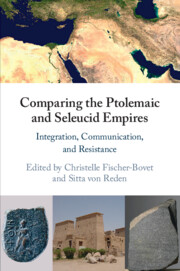Book contents
- Comparing the Ptolemaic and Seleucid Empires
- Comparing the Ptolemaic and Seleucid Empires
- Copyright page
- Contents
- Contributors
- Preface
- Note on Abbreviations
- Maps
- Introduction
- Part I Cities, Settlement and Integration
- Part II Communication and Exchange
- Chapter 5 Imperial and Indigenous Temporalities in the Ptolemaic and Seleucid Dynasties
- Chapter 6 The Visual Representation of Ptolemaic and Seleucid Kings
- Chapter 7 Monetary Policies, Coin Production, and Currency Supply in the Seleucid and Ptolemaic Empires
- Part III Collaboration, Crisis, and Resistance
- Bibliography
- Index
Chapter 7 - Monetary Policies, Coin Production, and Currency Supply in the Seleucid and Ptolemaic Empires
from Part II - Communication and Exchange
Published online by Cambridge University Press: 17 September 2021
- Comparing the Ptolemaic and Seleucid Empires
- Comparing the Ptolemaic and Seleucid Empires
- Copyright page
- Contents
- Contributors
- Preface
- Note on Abbreviations
- Maps
- Introduction
- Part I Cities, Settlement and Integration
- Part II Communication and Exchange
- Chapter 5 Imperial and Indigenous Temporalities in the Ptolemaic and Seleucid Dynasties
- Chapter 6 The Visual Representation of Ptolemaic and Seleucid Kings
- Chapter 7 Monetary Policies, Coin Production, and Currency Supply in the Seleucid and Ptolemaic Empires
- Part III Collaboration, Crisis, and Resistance
- Bibliography
- Index
Summary
This chapter concentrates on a medium that was closely related to central government structures, though the authors detect some possibilities of local (civic) involvement in the design of coinages. Seleucid coin policy was much more heterogeneous than the closed monetary system of the Ptolemies, thus providing better opportunities for establishing patterns of change and transformation. Iossif demonstrates that local control marks displayed continuity and stability in local bureaucracies during political upheaval and change. Lorber, looking at Ptolemaic coins, shows a much more patterned development, related to the metal supply and to fiscal cycles. In the second century, the contrast between Seleucid and Ptolemaic monetary policies converged, whereby the region of Syria-Palestine played an important part. In Western Asia Minor, there are some indications that mint authority was shared between central and local governments. Continuities in local practice under different royal control emphasize the importance of local conditions shaping government responses. This supports their conclusion that the Seleucid and Ptolemaic dynasties adopted two different approaches to similar problems.
Keywords
- Type
- Chapter
- Information
- Comparing the Ptolemaic and Seleucid EmpiresIntegration, Communication, and Resistance, pp. 191 - 230Publisher: Cambridge University PressPrint publication year: 2021
- 1
- Cited by

